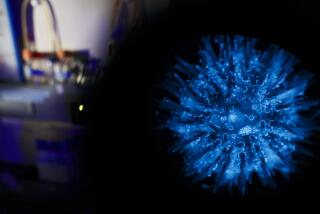The Cutting Edge: COMPUTING / TECHNOLOGY / INNOVATION : Cold-Loving Enzymes Could Become Hot Little Properties
- Share via
Need more cleaning power for your cold-water wash? Cold-loving enzymes from northern oceans may be the answer. Researchers at the University of Washington’s Sea Grant Program are studying marine bacteria with the goal of extracting enzymes that could be used for a wide variety of jobs, from culturing cheese to washing clothes.
Enzymes are proteins that act as catalysts in biochemical reactions. When used in detergents, for example, they bond with grease and dirt. The enzymes the researchers are studying can survive--and even reproduce--at subzero temperatures. This tolerance for cold would make them ideal for cold-water washes. Using cold water, rather than the hot water Americans traditionally associate with clean clothes, could lead to substantial energy savings. In the dairy industry, the enzymes could be used to sweeten milk, form curds and ripen cheese at colder temperatures, thus minimizing the chances for bacterial contamination.
A Current Event: A new imaging technique that allows scientists to “see” the electrical current flowing in high-temperature superconductors may be the key to developing superconductors that can carry 10 times more electrical current than is now possible. The process, called magneto-optical-flux imaging, was developed through a collaborative effort by Argonne National Laboratory, former Soviet scientists from the Institute of Solid State Physics and Phase Metrics Inc. of San Diego.
High-temperature superconductors carry current without losing energy through resistance, thus holding the promise of improvements in motors and generators and other advances. But superconducting materials are a type of ceramic, making them brittle and difficult to make into current-carrying wire long enough to have practical uses. Identifying the precise location in the material where the current flow stops would help researchers improve the material’s ability to carry current.
By surrounding a superconducting crystal in a magnetic field, researchers can see where the magnetic field seeps into areas in the lines called twin boundaries. These are the best paths for electrical current to flow. Thus the new imaging process allows scientists, as they experiment with different superconducting samples, to pinpoint the tiny particles that interrupt current flow. The new imaging technique recently won a U.S. Department of Energy 1995 Materials Sciences Award for solid state physics.
A Bigger Rice Bowl: Thanks to California’s dry climate, rice grown in the state isn’t bothered by bacterial blight. But in much of Asia and Africa, the disease can reduce rice yields by 50%. Because rice is the staple food of more than half the world’s population, the problem is a significant one. Now researchers at UC Davis have genetically engineered disease resistance into rice by isolating a gene that confers resistance to a species of the blight.
Although three species of crop plants have already been genetically engineered to ward off diseases, this is the first engineering of disease resistance in the large group of plants known as monocotyledonous, or monocots. About one-fourth of all plant species--including important food crops such as rice, wheat and corn--are monocots, meaning they have only one seed leaf. The blight-resistance gene in rice--known as Xa21--was one of eight genes tested. Xa21 or derivatives of this gene will be important in many other crops as well. Researchers are already working to transfer it into walnuts and tomatoes.
Hearing by Touch: Many people with a hearing impairment cannot benefit from traditional hearing aids. When that is coupled with a condition that cannot be corrected with inner ear surgery, the only source of help is a tactile hearing aid. This device picks up sound through a microphone on a hand-held unit connected to an array of tiny vibrators. The unit transforms sounds into patterns, which are then sent to the vibrators situated on a board inside a pouch.
The pouch can be worn on the ankle, the sternum, the back of the neck, or in a variety of other places on the body. Each vibrator in the display is sensitive to a different frequency. Low frequency sounds such as “oooo” are felt at one end, high frequency sounds such as “ssss” are felt at the opposite end, and mid-range frequency sounds such as “aaaa” are felt in the middle of the instrument.
But researchers at Ohio State University have found that tactile devices are better at translating certain types of sounds than others. People using the devices, for example, seem to discriminate consonant sounds better than vowels. It also takes a long time and a lot of intense training to become good at using a tactile aid.
After studying a number of commercially available tactile aids as well as laboratory prototypes, the researchers found that a program that first trains participants to distinguish a specific set of language sounds is more successful than one in which users have to learn the entire spectrum at once. The research found that the aids are even more helpful when used with lip-reading.
Soybean Glue: An enzyme from soybean hulls known as peroxidase is taking on a greater presence in industrial chemistry. It is now being used as a replacement for formaldehyde in glues and varnishes, to treat industrial and municipal waste water and to help clean up gas, oil and fertilizer spills.
Peroxidase is a class of oxidative enzymes found in all plants and in milk and white blood cells. However, soybean peroxidase is a superior performer in industrial applications. Now an easy-to-use kit developed at Purdue University in Indiana will make it possible to monitor peroxidase levels at any stage of its production or use, from soybean to processed product to industrial chemical.
Because the kit produces results in minutes, it could be used to test soybean lines for levels of peroxidase.






